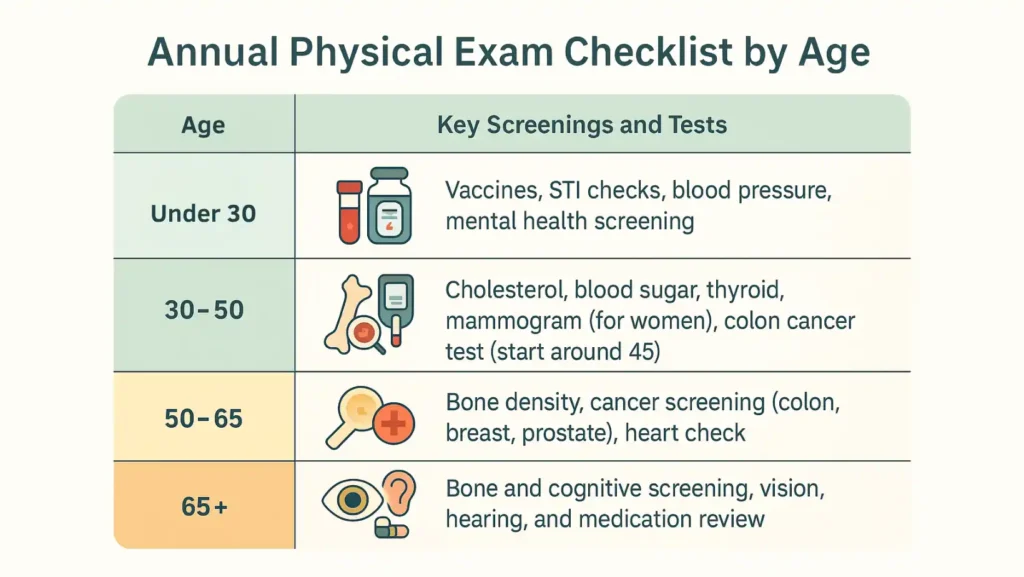An annual physical exam is a complete yearly checkup that helps your doctor understand your overall health, detect problems early, and prevent future diseases. It’s not only about checking your blood pressure or weight; it’s about reviewing every system in your body, updating vaccinations, reviewing lifestyle habits, and creating a personalized plan to keep you healthy for the next year.
Table of Contents
ToggleWhether you’re in your twenties or your seventies, a yearly exam builds a record of your health that allows doctors to notice small changes before they turn serious.
What Is an Annual Physical Exam?
Definition and purpose of yearly checkups
An annual physical exam is a full health review you do once a year with your primary care doctor. The main goal is to maintain health, prevent disease, and track your body’s changes over time. It’s like a maintenance check for your body, ensuring everything is running smoothly and catching small issues early.
Difference between physical and sports exams
A sports exam focuses on safe play. It checks joints and the heart for sports stress. A standard annual physical exam looks at overall health and long-term risk. Sports exams focus on clearance for activity.
Why annual exams are essential for long-term health
Yearly visits catch risks before they get worse. You can change habits early. You can start with simple treatments. This lowers the chance of major disease later on.
What happens during a standard physical exam
You give a health history. A nurse records weight and blood pressure. The doctor listens to your heart and lungs. The doctor checks reflexes and organs. They may order lab tests and imaging if needed.
What Does a Physical Exam Include?
Review of health history and lifestyle
You explain past illnesses and surgeries. You list medicines and allergies. You tell the doctor about sleep, diet, exercise, and mood. Family health history helps the doctor pick tests.
Vital sign checks (blood pressure, pulse, temperature)
Staff measure blood pressure and pulse. They check the temperature. These numbers show basic health. High blood pressure or a fast pulse needs more checks.
Head-to-toe physical assessment
The doctor inspects the eyes, ears, mouth, and throat. They check the neck for swelling. They press the belly to find pain. They test joints and skin for any changes.
Laboratory tests and screenings
Common tests include blood sugar, cholesterol, and a complete blood count. You might get liver and kidney checks. Women may get Pap tests, and men may discuss prostate checks.
Doctor’s counseling and health advice
You get clear steps to improve health. The doctor sets short-term goals. They teach safer habits and suggest follow-up plans. You may get vaccine updates.
Annual Physical Exam Checklist by Age.
Annual physical exam checklist by age annual physical exam The doctor may test thyroid levels if you feel tired. Follow the annual physical exam checklist by age for routine timing. You need bone checks to lower fracture risk. Use the annual physical exam checklist by age to track what comes next.
| Age Range | Key Screenings and Tests |
| Under 30 | Vaccines, STI checks, blood pressure, mental health screening |
| 30–50 | Cholesterol, blood sugar, thyroid, mammogram (for women), colon cancer test (start around 45) |
| 50–65 | Bone density, cancer screening (colon, breast, prostate), heart check |
| 65+ | Bone and cognitive screening, vision, hearing, and medication review |
Under 30: Basic screenings and vaccinations
You need routine vaccines and mental health checks. Discuss sexual health when needed. Your doctor may test for anemia or infections if signs appear.
30–50: Blood sugar, cholesterol, and thyroid checks
At these ages, watch cholesterol and blood sugar. The doctor may test thyroid levels if you feel tired. These screens detect risks early and guide lifestyle changes.
50–65: Cancer screenings and heart health evaluation
Start colon cancer screening at the right age. Check heart risk with cholesterol and blood pressure. Screen for cancers tied to family history or symptoms.
65+: Bone density and cognitive health tests
You need bone checks to reduce fracture risk. Memory checks screen for early dementia. Review all medicines to cut side effects and avoid interactions.
Preventive care updates and follow-up recommendations
The doctor sets when to repeat tests. They schedule vaccines and imaging if needed. You get a clear plan for the next year and reminders for care.
Annual Physical Exam Checklist for Female
The annual physical exam checklist for female lists key exams for women. Pap tests screen for cervical cell changes. Follow the annual physical exam checklist for females for timing. Mammograms often start near age 40 for average risk. See the annual physical exam checklist for females for age-based rules.
Breast and pelvic examination
Clinical breast exams check for lumps. Pelvic exams look at the uterus and ovaries. The doctor explains what they feel and why.
Pap smear and HPV testing
Pap tests screen for cervical cell changes. HPV tests check for the virus that can cause those changes. Timing depends on age and past results.
Bone health, thyroid, and cholesterol screening
Women face bone loss after menopause. The doctor may check thyroid and cholesterol to prevent heart and bone problems.
Menstrual and reproductive health review
Discuss cycle changes and painful periods. Talk about pregnancy plans and birth control. Ask about options if you plan a pregnancy.
Age-based cancer screening guidelines
Mammograms usually start near age forty for average risk. Cervical screening follows set age rules. The doctor tailors screening to your history.
Male Annual Physical Exam Checklist
The male annual physical exam checklist highlights tests for men. The doctor may discuss prostate screening risks and benefits. Use the male annual physical exam checklist to know age timing. Colon cancer screening starts around forty-five. Refer to the male annual physical exam checklist for details.
Prostate health and testicular exam
The doctor may discuss prostate screening and prostate-specific antigen if you are at risk. They check the testicles for lumps. Learn self-exam steps when advised.
Blood pressure and cardiovascular screening
Heart checks include blood pressure and often cholesterol. The doctor may order an EKG if you have risk factors or symptoms. Early detection guides treatment.
Hormone, cholesterol, and diabetes testing
If you feel low energy, a testosterone check may help. Cholesterol and sugar tests screen for heart disease and diabetes. These tests guide medicine choices.
Weight, fitness, and mental health assessment
Doctors assess weight and activity. They ask about mood, stress, and sleep. They offer support or referrals when you need help.
Screening for colon, lung, or prostate cancers by age
Colon cancer screening starts around forty-five for average risk. Lung screening may apply to heavy smokers. Prostate testing depends on age and risk.
Annual Physical Exam for Work or Employment.
What employers require in a physical exam
Work exams often verify fitness for duties. An annual physical exam for work online may serve as a remote precheck. Employers set tests based on job hazards. They often need vision and hearing checks.
Fitness-for-duty and occupational health tests
Tests focus on job safety. They include drug screens and ability checks. This ensures you can work without harming yourself or others. Employers may accept an annual physical exam for work-related reports.
How to get certified for work-related physicals
A licensed clinician completes the exam and fills out forms. Employers may accept an annual physical exam for work online reports as part of pre-screening. You may need lab tests and vision reports.
Lab tests, vision checks, and documentation
Work exams include required forms. Labs and vision results are part of the record. Keep copies for your files and know your rights.
Annual Physical Exam Near Me: How to Find One.
Local clinics, hospitals, and urgent care centers
Search local clinics and hospitals for primary care. Use the phrase annual physical exam near me in searches to find options. Use your insurance directory to find in-network offices. That lowers cost.
How to book an appointment conveniently?
Many clinics let you book online. Type annual physical exam near me to see nearby clinics. You can call. Book morning slots if you need fasting labs.
Choosing between in-person and telehealth options
Use telehealth for counseling and follow-up. For full annual physical exam testing and shots, choose an in-person visit. Still searching for an annual physical exam near me if you need an in-person visit.
What to ask before scheduling your exam?
Ask what tests the clinic includes. Ask if you need to fast. Ask about costs and paperwork. Ask whether the results go to your regular doctor.
Annual Physical Exam Online: What’s Possible
Virtual consultations for follow-up and pre-screening
You can get pre-visit consults online. The doctor reviews your history and directs testing. Virtual checks save time but cannot replace hands-on exams.
Home collection kits for blood or urine tests
Some services send home kits for simple tests. You follow directions and mail samples back. The doctor reviews results and guides next steps.
Limitations of online physical exams
Virtual visits cannot measure blood pressure or do imaging. They cannot do pelvic or breast exams. These checks need an in-person visit.
When in-person visits are still necessary
If you need shots, imaging, or a full exam, go in person. New or serious symptoms require urgent care. Follow your doctor’s advice.
Preparing for Your Annual Physical Exam
What to bring: ID, insurance, medication list
Bring your ID and insurance card. Bring a full list of medicines and doses. Bring recent test results and questions. Bring a notebook if it helps.
How to fast before lab work if required
If fasting is needed, only drink water. Avoid food for the time the lab states. Bring snacks for after the tests.
Questions to ask your doctor during the visit
Ask about needed tests and vaccine timing. Ask what a result means and what comes next. Ask about treatment options and goals.
How to prepare mentally for sensitive screenings
Tell the doctor your worries. Ask the staff to explain the steps. Bring a friend for support if that helps you relax.
How Long Does a Physical Exam Take?
Typical duration for a standard annual checkup
A standard visit takes about thirty minutes. Add more time for tests and counseling. New patient visits may take longer.
Additional time for lab and imaging tests
Blood draws add ten to twenty minutes. Imaging can add longer. Plan half a day if you expect many tests.
Online or workplace exams vs full clinic visits
Work exams can be brief. Full clinic visits take longer. Online visits tend to be short and focused on specific issues.
What Happens After Your Annual Checkup?
Reviewing your results and next steps
The doctor reviews the results with you. They explain abnormal findings. They set follow-up steps and referrals. You get a written care plan.
Follow-up appointments for abnormal findings
If tests show issues, you get another visit or a specialist referral. Early action helps treat problems sooner and reduce complications.
Updating vaccination and medication records
The doctor updates your vaccine record. They adjust medicines if side effects appear. Keep a personal health file and share it with new doctors.
Building a long-term preventive care plan
You get a plan for screenings and health goals. Regular checks track progress. They help you lower risk over the years.
Common Tests During a Yearly Physical
Blood pressure, glucose, and cholesterol
These tests measure heart and metabolic risk. They guide diet and medicine choices. Repeat tests show whether treatments work.
Complete blood count and liver panel
CBC checks red and white blood cells. Liver panels test organ function. Abnormal results need more checks and specialist input.
BMI and body composition evaluation
BMI measures weight for height. Some clinics check body fat. Use numbers to set firm, healthy goals, not to shame yourself.
Cancer and thyroid screening options
Thyroid tests check hormone levels. Cancer screening follows age and risk. Your doctor explains which tests apply to you.
When to See a Doctor Between Annual Exams?
Persistent fatigue, dizziness, or chest pain
These symptoms need prompt care. Chest pain needs emergency care. Do not wait for your yearly visit if these occur.
Unexpected weight changes or bleeding
Sudden weight shifts or any unusual bleeding require quick medical attention. Report these signs to your doctor right away.
Chronic stress or sleep disturbances
If stress or lack of sleep affects your daily life, ask your doctor for help. There are simple treatments and supports available.
New or unexplained symptoms post-exam
If new symptoms appear after your visit, schedule another appointment. Early review avoids bigger problems later.
FAQs
How much does an annual physical exam cost?
Costs vary by clinic and insurance. Preventive exams often have low or no copay. Check your insurer and call clinics for exact pricing before you book to avoid surprise costs.
How often should I get a physical exam?
You should get an annual physical exam once every year. If you have a chronic disease, your doctor may want to visit more often to monitor treatment and adjust care as needed.
Can I do an annual physical exam online?
You can do parts of an annual physical exam online for counseling and follow-up. A full physical with tests and shots still needs an in-person visit to a clinic.
What should I bring to my physical appointment?
Bring your ID, insurance card, full medicine list, and recent test results. Bring questions and family health history. This helps the doctor make fast, useful decisions for you.
How do I find an annual physical exam near me?
Use your insurance directory to find in-network doctors. Search clinics online and read local reviews. Type annual physical exam near me to find options in your area quickly.
Do I need to fast before my physical exam?
Fasting depends on ordered labs. For fasting glucose or lipid tests, avoid food for the hours your clinic specifies. Drink water and follow lab directions for accurate results.
What happens after the exam?
You receive test results and a care plan. Doctors explain abnormal results and schedule follow-ups. Update vaccines and medicines. Keep records and follow the recommended steps.
Can telehealth replace an in-person physical?
Telehealth can replace some visits for counseling and result review. It cannot replace all aspects of a full physical exam that require hands-on checks and imaging.
What age-based screenings are required annually?
Screenings depend on age and risk. Your doctor follows guidelines and family history to pick yearly checks. Common screens include blood pressure, cholesterol, and specific cancer screens.
Why is an annual exam important for prevention?
An annual physical exam finds early signs of disease. Early care reduces complications. A yearly plan keeps tests up to date and helps you avoid more serious problems later.

This article is medically reviewed by Dr. Chandril Chugh, Board-Certified Neurologist, providing expert insights and reliable health information.
Dr. Chandril Chugh is a U.S.-trained neurologist with over a decade of experience. Known for his compassionate care, he specializes in treating neurological conditions such as migraines, epilepsy, and Parkinson’s disease. Dr. Chugh is highly regarded for his patient-centered approach and dedication to providing personalized care.










